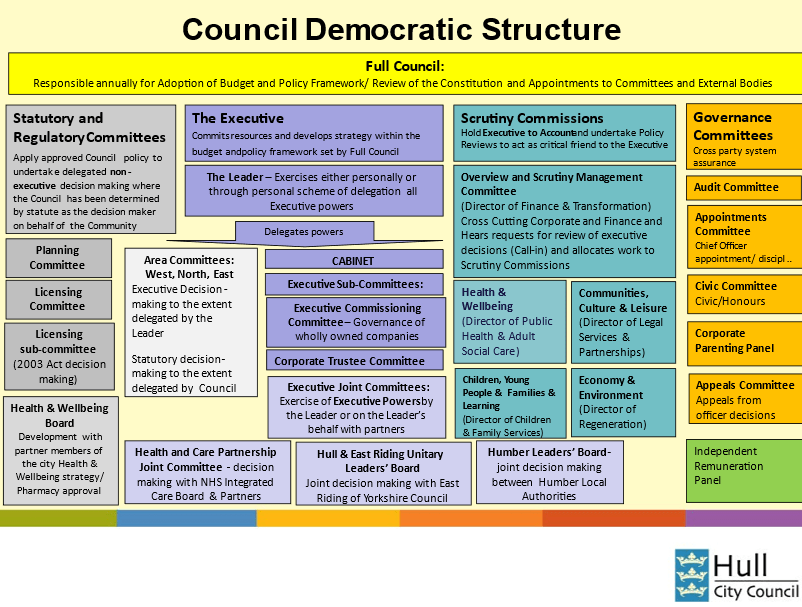In this section
Who we are and what we do
Hull City Council is the unitary authority and governing body for the city of Kingston upon Hull. As a unitary authority, it handles all local government functions undertaken within its area.
We have a history traced back through our predecessor, the Hull Corporation, to its original foundation by the royal charter of 1299. This is archived in the History Centre in the city. Hull is Yorkshire’s port on the confluence of the Humber Estuary. It is the fourth-largest city in Yorkshire and the Humber.
Decision-making of Local Government functions is undertaken within the council's democratic structure. This is established by the council members elected by the local community to make decisions on their behalf.
Council's democratic structure and the constitution
The council has determined to exercise its executive powers through the leader and cabinet model of governance provided for within the Local Government Act 2000.
Under this structure, the council elects or confirms the member of the council who will be the leader of the council. This is after the election by the community of the members of the council who will represent them. The leader exercises either personally or through members of the cabinet that the leader appoints all executive powers of the council.
The functions of the council that cannot be the responsibility of the executive are -
- planning
- licensing
- scrutiny
or that council has determined, where it has power to do so, will not be the functions of the executive, and are exercised through committees. This is to which elected members are appointed on a proportionate basis. It reflects the balance of the political groups on the council.
The framework for decision-making is described in the Articles of the Constitution. They form Part A of the Constitution.
The overall council Scheme of Delegation is set out within Part B of the Constitution. It sets out the Terms of Reference of all council committees and joint committees. It also sets out the responsibilities of the council’s chief officers.
The leader of the council delegates executive decision-making powers through the Leader’s Scheme of Delegation. This is presented each year at the Annual Meeting of Council.
The rules within which council members and officers need to exercise the management of the council and make decisions on behalf of the community are set out at Part C of the Constitution.
The arrangements rely upon an understanding of the respective roles of the members. These members are the elected representatives of the community and the officers who put into effect the decisions of the council. Part D of the Constitution sets out the framework. Within this, members and officers work together to deliver outcomes on behalf of the community.
The governance of the council is reviewed annually. It is reviewed through the Annual Governance Statement and Code of Governance. It is then reported in draft form to the council’s audit committee at its summer meeting. This is in advance of confirmation by the leader and chief executive.
Every local authority must appoint a monitoring officer. As well as other duties, the monitoring officer has a key role in promoting and maintaining high standards of conduct amongst members of the authority.
It includes guiding members of the council to help them follow the Code of Conduct. This is as well as the council’s other rules and procedures. At Hull City Council, the monitoring officer is the assistant director (Legal and Governance).
The governance structure within the council’s constitution can be understood from the diagram below.

Council directorate structure
The council undertakes its activity through an officer management structure. This is set out in the Scheme of Delegation within the council’s constitution. It is led by the chief executive and the Head of Paid Service. The chief executive manages the responsibilities of the council through 5 Directorates. Each Directorate is aligned to a scrutiny committee or commission.

